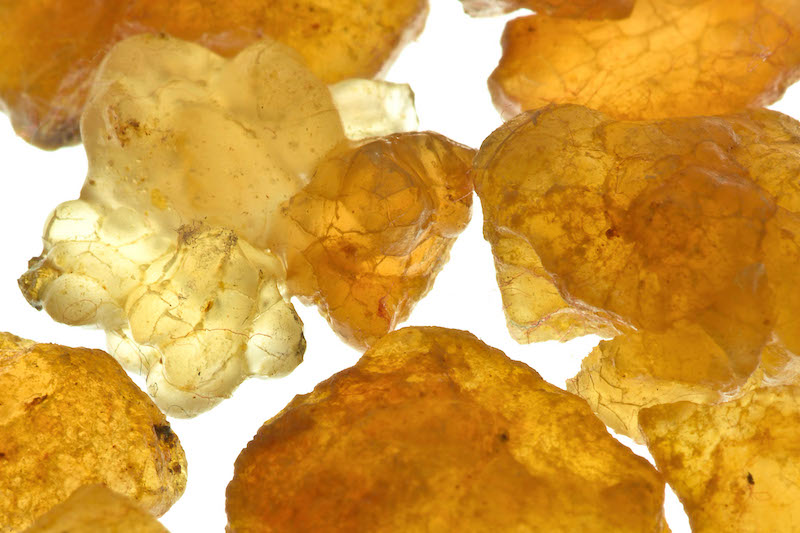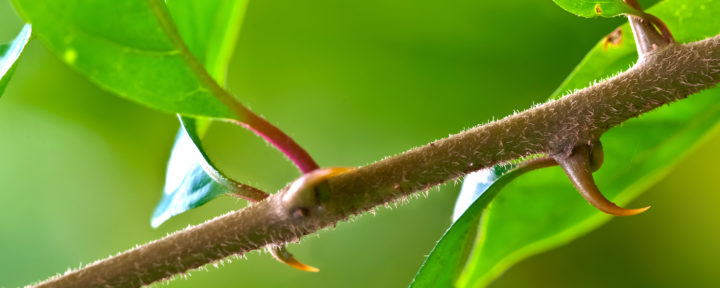Myrrh
Commiphora spp.
Burseraceae – Frankincense family
- none
Details & Ingredients
BOTANICAL DESCRIPTION
Myrrh is a shrub or small tree that is usually less than 13 feet (4 meters) tall.1 It has a short trunk and knotted branches covered in spines.1 The outer bark is generally a silver or gray tone and may be peeling away from its green under-bark.1 Cuts in the bark exude a hard yellow-toned oleo-gum-resin.1 Yellow-red flowers usually appear before the leaves and are 3 to 4 mm long, with two to four in a cymose inflorescence.1 Its widely variable trifoliate leaves have a terminal leaflet with two smaller lateral leaflets, which have an entire to six-toothed margin.1,5,6 Myrrh has one to two flattened beaked drupe fruits on jointed stalks.1,5,7
oleo-gum-resin
Prominent Constituents as Reported in Scientific Literature: Gum, resin, complex polysaccharides, triterpenoids, triterpene acids, sesquiterpenes, furanosesquiterpenes, and volatile oil.3,5
TurkeyES
Traditional support for the immune system*
DID YOU KNOW?
Myrrh is used for incense, perfume, and dessert flavoring as its resin is quite fragrant.6
INFORMATION
Myrrh is native to Somalia, Ethiopia, Kenya, Saudi Arabia and Oman.1 In the earliest history of trade, the herb was an “offering of value,” as it is often mentioned in the Bible.8 The first recorded effort of domestication of Myrrh occurred in 1495 when Queen Hatshepsut of Egypt sent an expedition to Somalia to bring back trees that produced fragrant resin.1 It is said that 31 trees were brought back in wicker baskets slung on poles, then planted in the Garden of Thebes.1
The name Myrrh denotes “bitter” and is most likely of Arabic origin.8 The herb was one used in combination for embalming of Egyptian nobles and pharaohs.7
Myrrh is also used in Kyphi, a sweet, spicy and resinous incense that has been used since ancient Greece.4 The ingredients include raisins, wine, honey, mineral pitch, Myrrh, Lemongrass, Sweet Flag, Cyperus tuber, Saffron, Spikenard, Rosewood, Cardamom, and Cinnamon.4
The plant is valued in the landscape for its ability to prevent soil erosion caused by wind, and is often found flourishing in shallow soil, most often over limestone deposits.1 Myrrh is commonly found in bushland habitats among native flora and fauna and in desert scrubland thickets.1,6 In the forests on the shores of the Red Sea, the shrub was known to create an undergrowth.8 It prefers full sun, high temperatures, dry to moist soil, and is drought tolerant.6
The Myrrh oleo-gum-resin naturally oozes from the tree and hardens on the bark in sizes ranging from a pea to a large walnut.9 The irregular pieces were said to resemble the tree’s “tears,” which is now the commonly referred to plant part description.9 To collect the fragrant tears, trees are scored in several places on their main trunk or cut branches.2,6 These scores in the bark begin to produce a milky resin that hardens into an amber/reddish-brown tear as it begins to dry on the tree.2 After about two weeks, the tears are ready for collection and dried.2,6 If collected properly, this procedure does not harm the tree, and therefore doesn’t threaten the sustainability of Myrrh.2 A number of species produce chemically similar oleo-gum-resin and share the same uses in herbalism.
- World Agroforestry Centre. Agroforestree Database. 2019. (Agroforestree Database. 5 July 2019.) Nairobi, 00100, Kenya.
- Crow D. The Pharmacy of Flowers. Nevada City, CA: Floracopeia Publishing; 2005.
- Skenderi G. Herbal Vade Mecum. Rutherford, NJ: Herbacy Press; 2003.
- Holmes P. The Energetics of Western Herbs, Vol. 2. Boulder, CO: Snow Lotus Press; 2006.
- Van Wyk B, Wink M. Medicinal Plants of the World, 5th ed. Merkez, OR & London, England: Timber Press; 2012.
- Plants for a Future. 1996-2012. Plants for a Future Database (Plants For A Future, 18 March 2019). Devon EX7 9LX England.
- Cook W. H. A Compend of the New Materia Medica Together with Additional Descriptions of Some Old Remedies. Chicago, IL: Cook; 1896.
- Waggaman S. A Compendium of Botanic Materia Medica for Use of Students in Medicine and Pharmacy. Washington, D. C.: W. H. Lowdermilk & Co; 1895.
- King J. The American Eclectic Dispensatory. Cincinnati, OH: Moore, Wilstach & Keys; 1854.
Gallery




